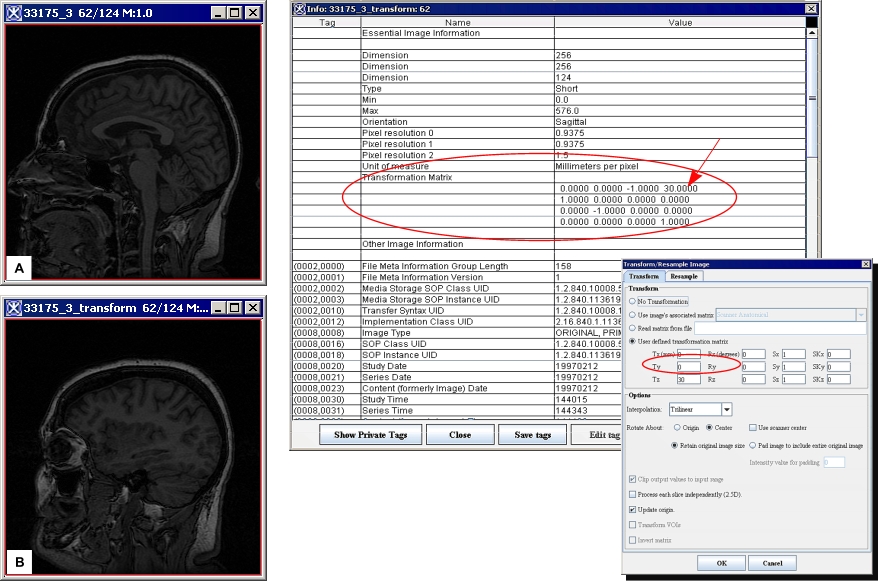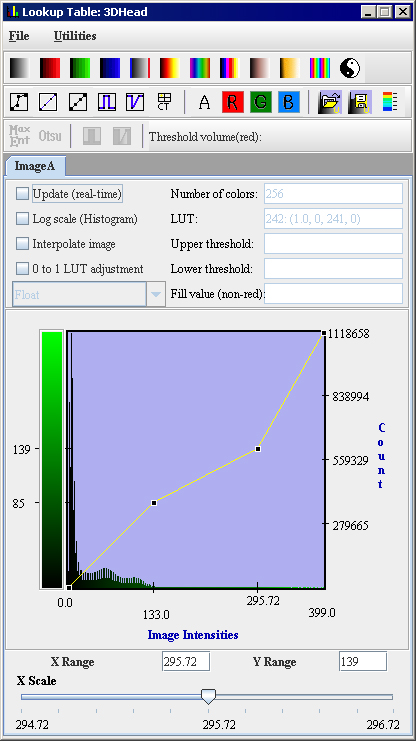Matrix, Plot, LUT, VOI and Surface files
Matrix file
What is it and what is its purpose?
The MIPAV matrix file provides identity information for an image. It describes the image's orientation, translations, offset scales, rotations, and shears. When any of this information changes in the image, the identity matrix changes.
When and how is it created?
Every image has an identity matrix. The matrix changes when you apply those algorithms or utilities to the image that change any of its identity information.
What does it look like?
If the image is currently open and active, you can view its matrix information by selecting Image > Attributes > View Header in the MIPAV window. The Information dialog box opens see below.
Where is it stored?
MIPAV stores matrix files in the same directory as its associated image.
Plot file
What is it and what is its purpose?
The MIPAV plot (PLT) file contains plot data for an intensity profile, or a graph generated for a given image.
When and how is it created?
MIPAV generates the plot file when you delineated a VOI on an image and then called the one of following intensity functions: Boundary Intensity, 2.5D Total Intensity, or 2.5D Average Intensity.
To call the Intensity function(s):
- Select one of the following in the MIPAV window:
- VOI > Graph > Boundary Intensity
- VOI > Graph > 2.5D Total Intensity
- VOI > Graph > 2.5D Average Intensity
What does it look like?
An example of a plot file appears in Figure 8, and Figure 9 shows a graph for this plot file.
The graph has five functions. Each function has 32 points. This file is read vertically. The first two columns show the x and y values for the first function. The next two columns show the x and y values for the second function, and so on. The first point of the first function is (1, 8), the second is (2, 9), and the third is (3, 18).
The first point for the fifth function is (1, 22400), the second is (2, 21700), the third is (3, 21000), and so on. The graph for this plot file appears in Figure 9.
|
1 8 1 30729 1 100 1 1000 1 224002 9 2 27878 2 200 2 2000 2 217003 18 3 25209 3 300 3 3000 3 210004 41 4 22716 4 400 4 4000 4 20300 5 84 5 20393 5 500 5 5000 5 19600 6 153 6 18234 6 600 6 6000 6 18900 7 254 7 16233 7 700 7 7000 7 18200 8 393 8 14384 8 800 8 8000 8 17500 9 576 9 12681 9 900 9 9000 9 16800 10 809 10 11118 10 1000 10 10000 10 16100 11 1098 11 9689 11 1100 11 11000 11 15400 12 1449 12 8388 12 1200 12 12000 12 14700 13 1868 13 7209 13 1300 13 13000 13 14000 Â [This part of the LUT file was removed to save space.] Â 27 18234 27 153 27 2600 27 27000 27 4200 28 20393 28 84 28 2700 28 28000 28 3500 29 22716 29 41 29 2800 29 29000 29 2800 30 25209 30 18 30 2900 30 30000 30 2100 31 27878 31 8 31 3000 32 32000 31 1400 32 30729 32 9 32 3100 33 33000 32 700
|
Where is it stored?
By default, the PLT file is stored in the same directory that holds the image. However, you can store it in any directory of your choice.
LUT file
LUT is a vector file format used to store MIPAV Lookup Table (LUT) data.
MIPAV provides a logical color map, which allows you to remap the original intensities to other intensities. Although technically the term look-up table (LUT) can be used for the physical and logical color maps, in this guide look-up table refers to the logical color map only. You can apply predefined, pseudo color or inverse LUTs, or you can manually manipulate the transfer function used to map the image data to the LUT. The LUT then translates the remapped values so that they can be interpreted by the physical color map and displayed on your monitor.
What is its purpose?
The lookup table (LUT) file holds lookup table values, which you can modify, for the active image currently being displayed.
When and how is it created?
MIPAV generates the LUT file when, after opening an image, you either create or save a corresponding lookup table. For example:
- Select the Lookup table icon, to call the Lookup Table window and display a lookup table for the image.
- Save the Lookup table by selecting LUT > Save or pressing Ctrl+S.
Where is it stored?
By default, the LUT file is stored in the same directory that holds the image.
What does it look like?
A figure below shows an example of a LUT file. The middle section of the file was removed in this example because of space limitations, and the column headings-alpha, red, green, and blue-were added to make it is easier to interpret the values. The column headings do not appear in the actual LUT file.
|
Alpha Red Green Blue <LUT> 256 # Size of LUT Arrays 0 1.0 0.0 0.0 0.0 1 1.0 0.99609375 0.99609375 0.99609375 2 1.0 1.9921875 1.9921875 1.9921875 3 1.0 2.9882812 2.9882812 2.9882812 4 1.0 3.984375 3.984375 3.984375 5 1.0 4.9804688 4.9804688 4.9804688 6 1.0 5.9765625 5.9765625 5.9765625 7 1.0 6.9726562 6.9726562 6.9726562 8 1.0 7.96875 7.96875 7.96875 9 1.0 8.964844 8.964844 8.964844 10 1.0 9.9609375 9.9609375 9.9609375 11 1.0 10.957031 10.957031 10.957031 12 1.0 11.953125 11.953125 11.953125 13 1.0 12.949219 12.949219 12.949219 14 1.0 13.9453125 13.9453125 13.9453125 [This part of the LUT file was removed to save space.] 251 1.0 250.01953 250.01953 250.01953 252 1.0 251.01562 251.01562 251.01562 253 1.0 252.01172 252.01172 252.01172 254 1.0 253.00781 253.00781 253.00781 255 1.0 254.0039 254.0039 254.0039 |
The LUT file is arranged in table row-column format. The LUT file contains 256 rows, numbered 0 to 255, which correspond to the number of intensities that can be displayed in the image. The first number assigned to the intensity described by the other numbers in that row. The second number is the alpha channel value. The alpha channel is the portion of each pixel's that indicates the opacity level of the intensity value. The number 1.0 indicates that the intensity is opaque; 0.0 indicates the intensity is transparent. Numbers in-between indicate varying translucency levels. The last three numbers indicate the values for the red, green, and blue channels, respectively.
VOI file
What is it and what is its purpose?
The MIPAV VOI file provides plots for contours that you have delineated on an image. Saving VOI information to a file means that it can be used again. In addition, if you create a script that includes algorithms that require VOIs, you need to save the VOIs so that the script can apply them to the images (refer to [MIPAV_Scripting.html#1298974 "Using Scripts (Macros) in MIPAV" ]).
An example of a VOI file:
0 # curveType of the VOI
255 # color of VOI - red component
0 # color of VOI - green component
0 # color of VOI - blue component
255 # color of VOI - alpha component
1 # number of slices for the VOI
8 # slice number
1 # number of contours in slice
38 # number of pts in contour
167.0 124.0
161.0 147.0
156.0 156.0
150.0 162.0
144.0 166.0
139.0 170.0
133.0 172.0
128.0 174.0
122.0 175.0
116.0 176.0
111.0 176.0
105.0 175.0
139.0 78.0
144.0 82.0
150.0 86.0
156.0 92.0
161.0 101.0
24862902 # unique ID of the V
When and how is it created?
MIPAV creates a VOI file when you create one or more VOIs on an image and then select one of the following commands in the MIPAV window:
- VOI > Save VOI
- VOI > Save VOI as
- VOI > Save All VOIs
- VOI > Save All VOIs to
Because MIPAV VOI file format is a simple ASCII format, it can be easily adapted to other formats. The contours are given as simple closed polygons. One cross-section may contain several polygons. A contour can reside inside another contour. They are oriented so the inside of a contour (material) is on the right side. The xy coordinates range from 0 to 512.
Where is it stored?
Although by default it is stored in same directory as the image, you can save it to another directory by selecting VOI > Save VOI as or VOI > Save All VOIs to, which open the Save window.
VOI XML file
What is it and what is its purpose?
The VOI XML (.xml) file provides plots for contours in an XML format.
Where is it stored?
Like VOI files, VOI XML files are stored, by default, in the same directory as the image. However, you can save them to another directory by selecting either VOI > Save VOI as or VOI > Save All VOIs to.
When and how is it created?
You can save VOIs as VOI files or VOI XML files. To do so, you delineate one or more VOIs on an image and then select VOI > Save VOI as or VOI > Save All VOIs to. In the Save dialog box, you simply type the file name with a .xml extension and click Save.
What does it look like?
An example of a VOI XML file is shown below. The middle part of the file was removed to save space.
An example of a VOI XML file
<?xml version="1.0" encoding="UTF-8" ?>
-
- <VOI xmlns:xsi="http://www.w3.org/2001/XMLSchema-instance">
<Unique-ID>24862902</Unique-ID>
<Curve-type>0</Curve-type>
<Color>255,255,0,0</Color>
- <Contour>
<Slice-number>8</Slice-number>
<Pt>167.0,124.0</Pt>
<Pt>161.0,147.0</Pt>
<Pt>144.0,166.0</Pt>
<Pt>139.0,170.0</Pt>
<Pt>133.0,172.0</Pt>
<Pt>128.0,174.0</Pt>
[This part of the LUT file was removed to save space.]
<Pt>144.0,82.0</Pt>
<Pt>150.0,86.0</Pt>
<Pt>156.0,92.0</Pt>
<Pt>161.0,101.0</Pt>
</Contour>
- <Contour>
<Slice-number>8</Slice-number>
<Pt>159.0,55.0</Pt>
<Pt>190.0,55.0</Pt>
<Pt>190.0,85.0</Pt>
<Pt>159.0,85.0</Pt>
</Contour>
</VOI>
Surface files
A surface area is the measure of how much exposed area a solid object has. It is usually expressed in square units. In medical imaging, curves and surfaces allow for the modeling of body parts and organs with complex curvature(s) in multiple coordinate directions.
MIPAV supports its own surface format (*.sur). A MIPAV surface file contains the information about the surface area and geometry, plus the additional information that describes the surface color and more. This is defined by an XML scheme, which can be found on the MIPAV web site.
MIPAV Surface format (Triangle mesh or ClodMesh - Continuous level of details mesh)
Inverse Dicom matrix flag
3D mesh direction x, y, z
Start location x, y, z
Bounding box x, y, z
Inverse Dicom matrix
Vertex quantity
Vertex position x, y, z
Vertex normal x, y, z
Index quantity
Index connectivity x, y, z
Surface material property
Clodmesh collapse record
See also: MIPAV API.
MIPAV surface file in text file format
MIPAV also uses ASCII text format to define surfaces. The text surface file records the triangle mesh vertices, normals and connectivity.
A sample surface defined in ASCII format:
Vertices
x, y, z // vertex position
Normal
x, y, z // normal coordinate
Connectivity
x, y, z // index connection


